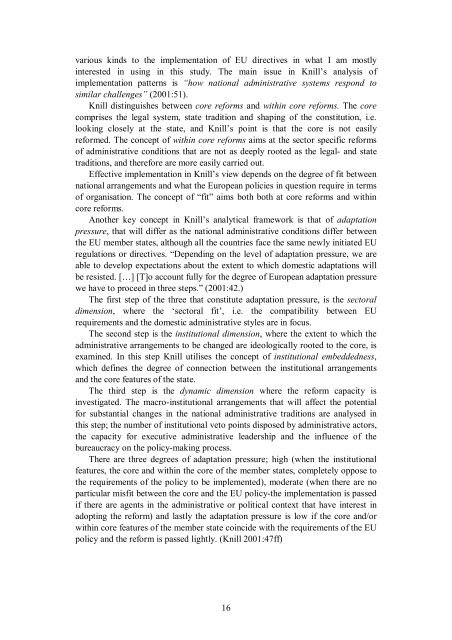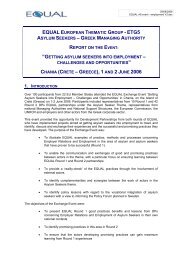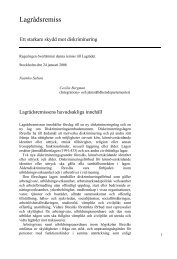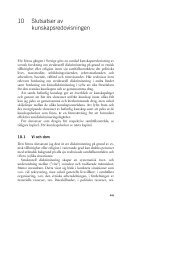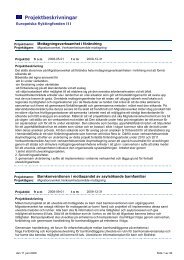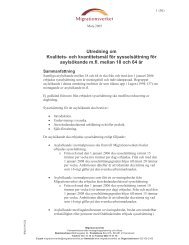The Common European Asylum System in Poland - Tema asyl ...
The Common European Asylum System in Poland - Tema asyl ...
The Common European Asylum System in Poland - Tema asyl ...
You also want an ePaper? Increase the reach of your titles
YUMPU automatically turns print PDFs into web optimized ePapers that Google loves.
various k<strong>in</strong>ds to the implementation of EU directives <strong>in</strong> what I am mostly<br />
<strong>in</strong>terested <strong>in</strong> us<strong>in</strong>g <strong>in</strong> this study. <strong>The</strong> ma<strong>in</strong> issue <strong>in</strong> Knill’s analysis of<br />
implementation patterns is “how national adm<strong>in</strong>istrative systems respond to<br />
similar challenges” (2001:51).<br />
Knill dist<strong>in</strong>guishes between core reforms and with<strong>in</strong> core reforms. <strong>The</strong> core<br />
comprises the legal system, state tradition and shap<strong>in</strong>g of the constitution, i.e.<br />
look<strong>in</strong>g closely at the state, and Knill’s po<strong>in</strong>t is that the core is not easily<br />
reformed. <strong>The</strong> concept of with<strong>in</strong> core reforms aims at the sector specific reforms<br />
of adm<strong>in</strong>istrative conditions that are not as deeply rooted as the legal- and state<br />
traditions, and therefore are more easily carried out.<br />
Effective implementation <strong>in</strong> Knill’s view depends on the degree of fit between<br />
national arrangements and what the <strong>European</strong> policies <strong>in</strong> question require <strong>in</strong> terms<br />
of organisation. <strong>The</strong> concept of “fit” aims both both at core reforms and with<strong>in</strong><br />
core reforms.<br />
Another key concept <strong>in</strong> Knill’s analytical framework is that of adaptation<br />
pressure, that will differ as the national adm<strong>in</strong>istrative conditions differ between<br />
the EU member states, although all the countries face the same newly <strong>in</strong>itiated EU<br />
regulations or directives. “Depend<strong>in</strong>g on the level of adaptation pressure, we are<br />
able to develop expectations about the extent to which domestic adaptations will<br />
be resisted. […] [T]o account fully for the degree of <strong>European</strong> adaptation pressure<br />
we have to proceed <strong>in</strong> three steps.” (2001:42.)<br />
<strong>The</strong> first step of the three that constitute adaptation pressure, is the sectoral<br />
dimension, where the ‘sectoral fit’, i.e. the compatibility between EU<br />
requirements and the domestic adm<strong>in</strong>istrative styles are <strong>in</strong> focus.<br />
<strong>The</strong> second step is the <strong>in</strong>stitutional dimension, where the extent to which the<br />
adm<strong>in</strong>istrative arrangements to be changed are ideologically rooted to the core, is<br />
exam<strong>in</strong>ed. In this step Knill utilises the concept of <strong>in</strong>stitutional embeddedness,<br />
which def<strong>in</strong>es the degree of connection between the <strong>in</strong>stitutional arrangements<br />
and the core features of the state.<br />
<strong>The</strong> third step is the dynamic dimension where the reform capacity is<br />
<strong>in</strong>vestigated. <strong>The</strong> macro-<strong>in</strong>stitutional arrangements that will affect the potential<br />
for substantial changes <strong>in</strong> the national adm<strong>in</strong>istrative traditions are analysed <strong>in</strong><br />
this step; the number of <strong>in</strong>stitutional veto po<strong>in</strong>ts disposed by adm<strong>in</strong>istrative actors,<br />
the capacity for executive adm<strong>in</strong>istrative leadership and the <strong>in</strong>fluence of the<br />
bureaucracy on the policy-mak<strong>in</strong>g process.<br />
<strong>The</strong>re are three degrees of adaptation pressure; high (when the <strong>in</strong>stitutional<br />
features, the core and with<strong>in</strong> the core of the member states, completely oppose to<br />
the requirements of the policy to be implemented), moderate (when there are no<br />
particular misfit between the core and the EU policy-the implementation is passed<br />
if there are agents <strong>in</strong> the adm<strong>in</strong>istrative or political context that have <strong>in</strong>terest <strong>in</strong><br />
adopt<strong>in</strong>g the reform) and lastly the adaptation pressure is low if the core and/or<br />
with<strong>in</strong> core features of the member state co<strong>in</strong>cide with the requirements of the EU<br />
policy and the reform is passed lightly. (Knill 2001:47ff)<br />
16


